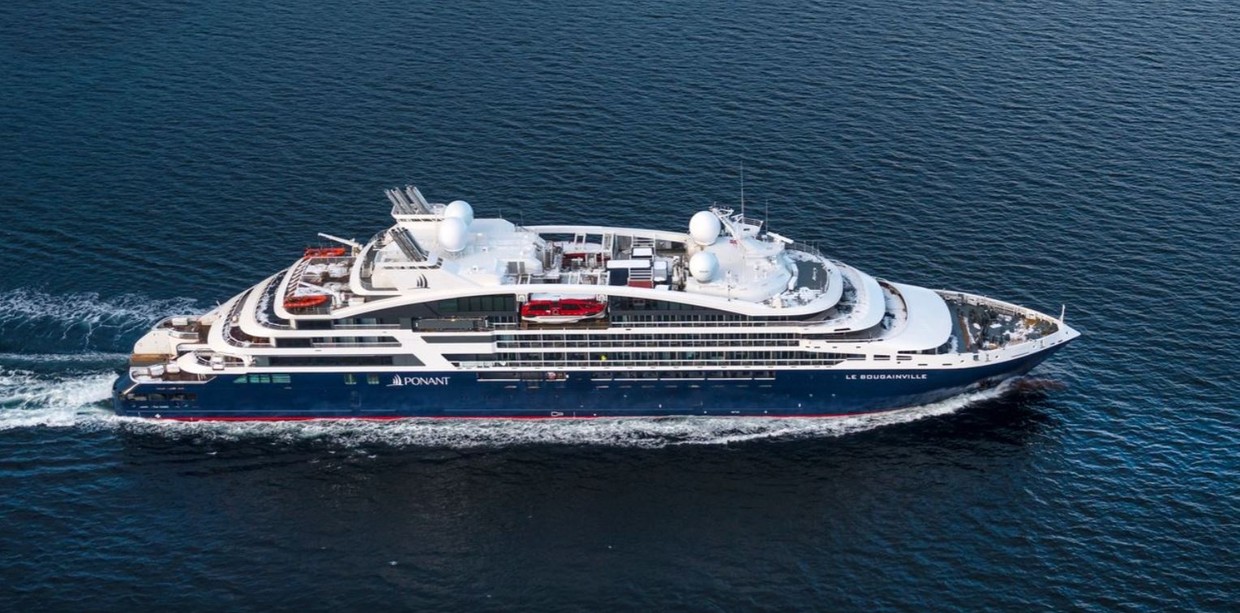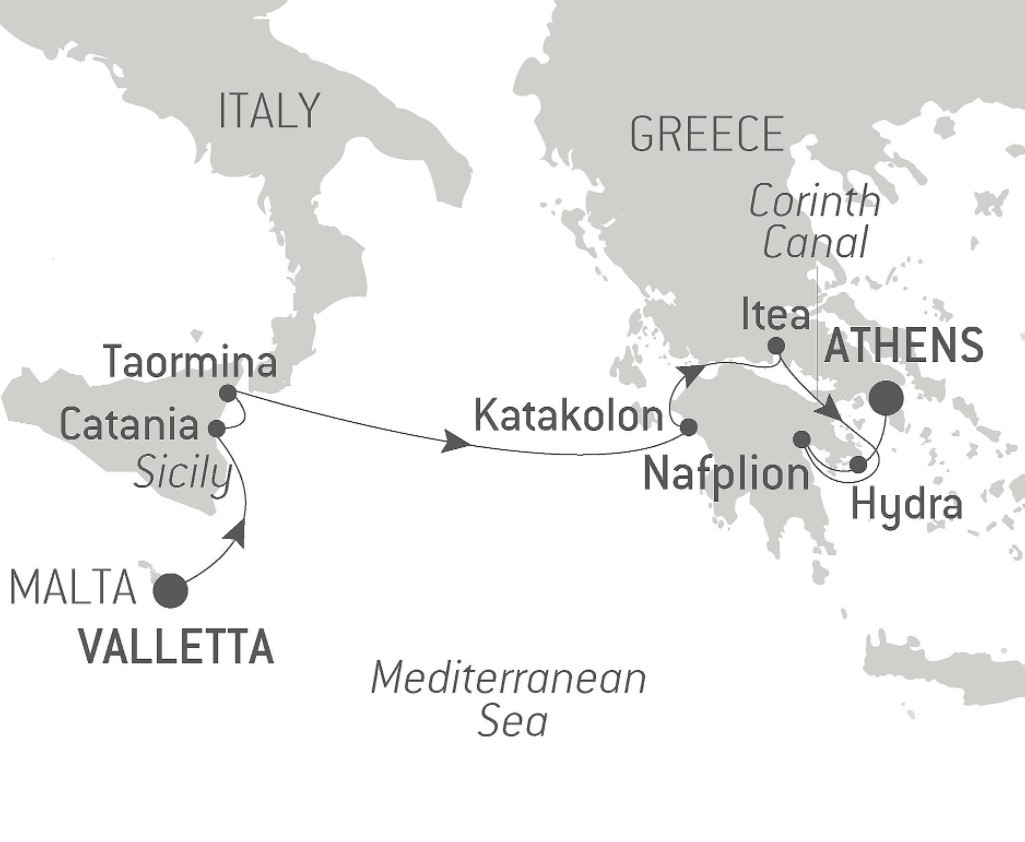2022-04-08
2025-01-01
Note: Current p/p indicative rate. Final price may change due to currency fluctuations.
From the island of Malta to Athens, PONANT invites you on an exceptional voyage with two ports of call in Sicily and four in Greece. Le Bougainville will leave Valletta, the capital of Malta and former stronghold of the Knights of the Order of Malta, for an 8-day cruise on seas that are brimming with history. After calling at beautiful Catania whose Late Baroque style monuments spread to the foot of Mount Etna, we will set sail for Taormina. In Taormina, the streets will lead you to the impressive ancient theatre, where the quality of the acoustics is exceptional. And as a constant backdrop: the majestic Mount Etna! Le Bougainville will then cross the Ionian Sea towards Katakolon, your first Greek point of call. From the port, you will head to Olympia, listed as a UNESCO World Heritage Site, whose ruins testify to its former grandeur. On the following day, from Itea, another exceptional site awaits: Delphi. Heading for Nafplion, your ship will then sail along the astonishing Corinth Canal, a famous sea channel dug out by men in the 19th century. From Nafplion you will able to visit two ancient jewels: the Epidaurus Theatre and Mycenae, the royal city of House of Atreus. The cruise will enable you to discover Hydra, a small island of old-worldly charm where motorised traffic is banned. This wonderful journey will end in Athens.
The whole of the Maltese capital Valletta is UNESCO World Heritage listed and occupies a peninsula in the north-east of the island. From the fountain of Tritons to Saint-Elme fort, there are as many majestic streets as there are narrow staircase vennels to explore. The painted loggia and carved corbels on the tall houses will accompany you in your explorations, and you’ll rarely be bothered by traffic. You can visit the Grandmasters palace decorated with coats of arms and frescoes. Saint-John’s cathedral and the ramparts which have guarded the city since the 16th century are also among the most emblematic sites of the city. Arranged in terraces, the Barrakka Gardens will punctuate your promenade with a green and floral experience.
Sicily’s second city Catania is dominated by the majestic silhouette of Mount Etna. Nourishing and devastating at the same time, this giant crowned with smoke rings brought about the destruction of the city at the end of the 17th century. Catania was then rebuilt in the late Baroque style, and the many monuments of this epoch have earned its status as a UNESCO World Heritage Site. The baroque churches of the harmonious Via dei Crociferi perfectly illustrate the riches of this architectural heritage. During your stop, be sure to visit Saint Agatha Cathedral with its apses made of lava stones, and its square decorated with a fountain of the Elephant, the animal which allegedly has the power to calm the fury of Mount Etna …
Located on Sicily’s eastern coast, in the province of Messina, the seaside town of Taormina is Sicily’s Saint-Tropez, boasting heritage sites, secluded beaches and luxury shopping. You can visit its medieval centre, suspended 300 metres above sea level, where terraces offer a spectacular view of the Mediterranean Sea. Another vestige from its past are the ruins of the Greco-Roman theatre. This extremely well-preserved site attracts visitors who are fascinated by the natural beauty of the area which overlooks a turquoise bay.
This picturesque village stretches along the Ionian sea in the west of the Peloponnese. Its main harbour offers a vast panorama of the coastline’s wooded hillsides. Dazzling white, the church of Saint-Nicolas houses a selection of sumptuous icons. You can also pay a visit the archaeological site of Olympus on the slopes of Mount Kronos.
Tucked away in the Gulf of Corinth, this little port is situated in continental Greece, north-west of Athens. Take an easy stroll along the old cobblestone quays, while gazing at the summits encircling the Bay of Itea. We wouldn’t be surprised if you are tempted by a visit to the Delphi Sanctuary. The sanctuary is located on a plateau on the slope of Mount Parnassus, just ten kilometres from Itea. A listed UNESCO World Heritage site, this is a once-in-a-lifetime experience whose ancient ruins are surrounded by steep mountains. The Corinth Canal cuts through the Isthmus of Corinth, turning the Peloponnese into an island as it separates the region from the Greek mainland. Inaugurated in 1893, the canal is a little over six kilometres long and enables merchant vessels and passenger to avoid a long 400-km detour around the peninsula. The two sides of the canal reach a height of approximately fifty metres. From the exterior decks, don’t miss this unique opportunity to watch the ship as it navigates along the narrow strip of water encased between tall, ochre cliffs. What an experience!
The engaging town of Nafplion is staggered up green hillsides of the Argolic Gulf, to the east of the Peloponnese. Do not be surprised by its extremely varied cultural heritage. Some of the must-see visits are the ancient agora on the plateau of Akronafplia, Italianate arcades in Syntagma square as well as the baroque fortress of Palamidi on a hillside of the same name. At the top of the hill, views of the gulf and the surrounding mountains are simply awesome. If you want to chill out by the water’s edge, walk along the Arvanitia promenade to a beautiful creek in the shade of cedars and cypresses.
This unusual gem belonging to the Saronic islands is located to the east of the Peloponnese. There are no cars here. Named after the island, the harbour town is layered up the slopes of a mountainous bay. You may be surprised to see beautiful stone mansions. These are traditional here, as are the multi-coloured caïques along the quays. Further along the shore, you will discover the Historical Archives Museum. Collections from Athens National History Museum are exhibited in the elegant villa Koundouriotis.
The Greek capital city is located on the edge of the Saronic gulf, in the east of the country. It bears a plural name in reference to the first villages that surround the Acropolis. You will be enchanted by the rocky plateau presided by its monuments listed as UNESCO World Heritage. In the city below, you can visit some of the liveliest districts in Athens: Plaka, with its maze of colourful streets, and where, in the evenings the drifting aroma of moussaka and garlic prawns will tickle your taste buds. The National Archaeological museum and the Cycladic Art Museum are also some of the city’s key attractions and allow visitors to discover Athens’ cultural past.
Itineraries are subject to change.

Vessel Type: Luxury Passenger Capacity: 92 cabins Built: 2017/2018 Featuring innovative and environmentally-friendly equipment, elegantly designed cabins, spacious suites with large windows, and lounge areas that open onto the outside, this new limited-capacity yacht boasting just 92 cabins and suites will offer you a truly unique cruising experience. As the first ship in a new series that remains true to the Ponant spirit, Le Bougainville will embody the unique atmosphere that is the cruise line’s hallmark: a subtle blend of refinement, intimacy and comfort. Aboard this ship that flies the French flag, you will experience the incomparable pleasure of an intimate cruise, with the possibility of exploring an ever-increasing range of destinations in an ethnic-chic ambiance with luxury service. Experience a luxurious setting where the accent is on authenticity and passion for travel. RESTAURANTS As it is an essential part of French culture, gastronomy will naturally have pride of place aboard this new ship. Through its two restaurants, Le Bougainville will invite you on a journey to elegance and epicureanism. In a relaxed atmosphere, a first dining area located on Deck 3 and able to seat 70 will serve grilled meats daily, along with a variety of salads and desserts. To the back of Deck 4, you will find a 260 m² panoramic restaurant which can accommodate all of our passengers in a single sitting. Designed differently to that on our other ships, this dining area, which opens onto the outside, will have a buffet of salads, desserts and cheeses at your disposal. Our discreet and attentive crew will provide table service for hot meals. PUBLIC AREAS Like Le Boréal and its sisterships, Le Bougainville has many common areas that are designed and equipped to meet all of your needs while preserving the intimacy of each passenger. A 140 m² reception area includes: A reception/concierge desk, An excursions desk, The ship’s administrative services, The sales office, manned by our Guest Relations Officer, Our 50 m² boutique which sells clothing, jewellery, beauty products, postcards and various accessories, Toilets accessible to passengers with reduced mobility. A new hydraulic platform with adjustable height provides: Easier boarding than on any other cruise ship, Easier Zodiac embarkation and disembarkation for expeditions, Easier access to the sea for swimming and practising various water sports such as kayaking or paddle-boarding. A pool deck offering: A pool with a panoramic view, equipped with a counter-current swimming system, A pleasant solarium, An outdoor bar and lounge with armchairs and sofas. A 200 m² main lounge which can accommodate all of our passengers to share convivial moments and to host activities organised during the day or evening. Lastly, a theatre that seats 188, equipped with: The latest sound and lighting technology, A LED wall as the stage backdrop, for the projection of high-resolution images and videos.
• UNESCO World Heritage Site: the Acropolis in Athens (embarkation port), the fabulous ancient Arab-Norman and Baroque heritage of Catania, Mount Etna from Taormina and its Greek Theatre, Delphi from Itea, the Mycenae ruins and the Epidaurus theatre (from Nafplion), Valletta (disembarkation port). • Sicily and its treasures including Catania and Taormina. • An unforgettable crossing of the Corinth Canal. • Charming port of call: Hydra, St Tropez for Athenians.
